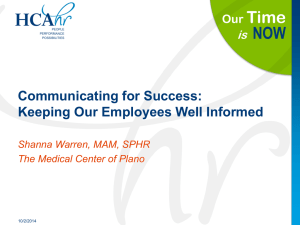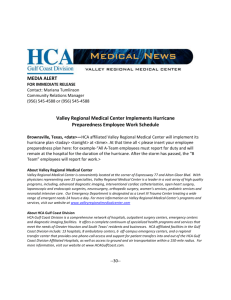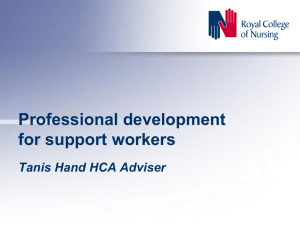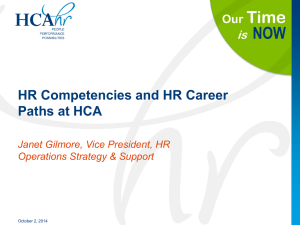A Giant Hospital Chain Is Blazing a Profit Trail
advertisement
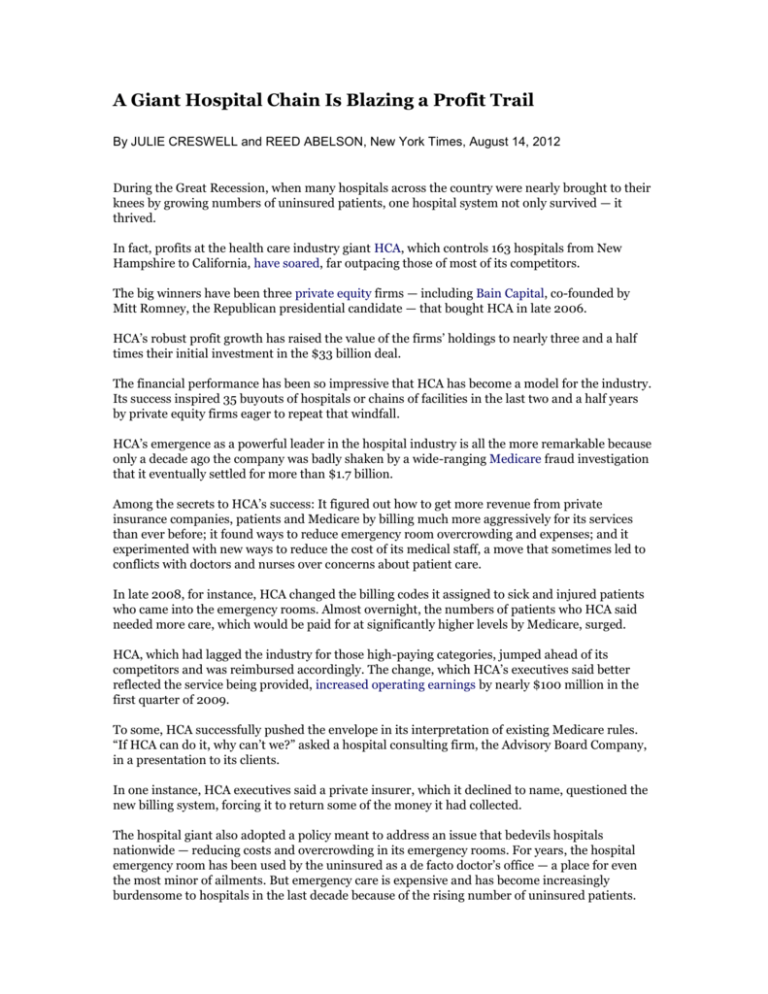
A Giant Hospital Chain Is Blazing a Profit Trail By JULIE CRESWELL and REED ABELSON, New York Times, August 14, 2012 During the Great Recession, when many hospitals across the country were nearly brought to their knees by growing numbers of uninsured patients, one hospital system not only survived — it thrived. In fact, profits at the health care industry giant HCA, which controls 163 hospitals from New Hampshire to California, have soared, far outpacing those of most of its competitors. The big winners have been three private equity firms — including Bain Capital, co-founded by Mitt Romney, the Republican presidential candidate — that bought HCA in late 2006. HCA’s robust profit growth has raised the value of the firms’ holdings to nearly three and a half times their initial investment in the $33 billion deal. The financial performance has been so impressive that HCA has become a model for the industry. Its success inspired 35 buyouts of hospitals or chains of facilities in the last two and a half years by private equity firms eager to repeat that windfall. HCA’s emergence as a powerful leader in the hospital industry is all the more remarkable because only a decade ago the company was badly shaken by a wide-ranging Medicare fraud investigation that it eventually settled for more than $1.7 billion. Among the secrets to HCA’s success: It figured out how to get more revenue from private insurance companies, patients and Medicare by billing much more aggressively for its services than ever before; it found ways to reduce emergency room overcrowding and expenses; and it experimented with new ways to reduce the cost of its medical staff, a move that sometimes led to conflicts with doctors and nurses over concerns about patient care. In late 2008, for instance, HCA changed the billing codes it assigned to sick and injured patients who came into the emergency rooms. Almost overnight, the numbers of patients who HCA said needed more care, which would be paid for at significantly higher levels by Medicare, surged. HCA, which had lagged the industry for those high-paying categories, jumped ahead of its competitors and was reimbursed accordingly. The change, which HCA’s executives said better reflected the service being provided, increased operating earnings by nearly $100 million in the first quarter of 2009. To some, HCA successfully pushed the envelope in its interpretation of existing Medicare rules. “If HCA can do it, why can’t we?” asked a hospital consulting firm, the Advisory Board Company, in a presentation to its clients. In one instance, HCA executives said a private insurer, which it declined to name, questioned the new billing system, forcing it to return some of the money it had collected. The hospital giant also adopted a policy meant to address an issue that bedevils hospitals nationwide — reducing costs and overcrowding in its emergency rooms. For years, the hospital emergency room has been used by the uninsured as a de facto doctor’s office — a place for even the most minor of ailments. But emergency care is expensive and has become increasingly burdensome to hospitals in the last decade because of the rising number of uninsured patients. HCA decided not to treat patients who came in with nonurgent conditions, like a cold or the flu or even a sprained wrist, unless those patients paid in advance. In a recent statement, HCA said that of the six million patients treated in its emergency rooms last year, 80,000, or about 1.3 percent, “ chose to seek alternative care options.” “Many E.R.’s in America, particularly in densely populated urban areas where most HCAaffiliated facilities are located, have adopted a variety of systems to determine whether a patient in fact needs emergency care,” the statement said. “About half our hospitals have done so. Typically, our affiliated hospitals have two caregivers — usually a triage nurse and a physician — make that determination. It should be noted that other non-HCA affiliated hospitals are using similar processes to address E.R. issues.” As HCA’s profits and influence grew, strains arose with doctors and nurses over whether the chain’s pursuit of profit may have, at times, come at the expense of patient care. HCA had put in place a flexible staffing system that allowed it to estimate the number of patients it would have each day in its hospitals and alter the number of nurses it needed accordingly. Several nurses interviewed said they were concerned that the system sometimes had led to inadequate staffing in important areas like critical care. In one measure of adequate staffing — the prevalence of bedsores in patients bedridden for long periods of time — HCA clearly struggled. Some of its hospitals fended off lawsuits over the problem in recent years, and were admonished by regulators over staffing issues more than once. ‘Through the Roof’ Many doctors interviewed at various HCA facilities said they had felt increased pressure to focus on profits under the private equity ownership. “Their profits are going through the roof, but, unfortunately, it’s occurring at the expense of patients,” said Dr. Abraham Awwad, a kidney specialist in St. Petersburg, Fla., whose complaints over the safety of the dialysis programs at two HCA-owned hospitals prompted state investigations. One facility was fined $8,000 in 2008 and $14,000 last year for delaying the start of dialysis in patients, not administering physician-prescribed drugs and not documenting whether ordered tests had been performed. Claiming he provided poor care, the other hospital did not renew Dr. Awwad’s privileges. Dr. Awwad is suing to have them reinstated. HCA declined to comment. HCA says it stands by its procedures, billing practices and level of care. HCA says that more than 80 percent of its hospitals ranked among the top 10 percent in the country for federal quality measures, compared with 13 percent in 2006 when it went private. Last year, the company provided a $2.68 billion provision for charity care. And under the control of its private equity owners, HCA has invested around $8 billion in its hospitals in the last five years, according to Securities and Exchange Commission findings. “You must know that we firmly believe that there is no sustainable business model as a health care delivery system that does not have at its core the provision of high-quality patient care and services,” HCA’s chief executive, Richard M. Bracken, wrote in an e-mail to The New York Times last year. Achieving a balance between profit and care is harder for investor-owned hospitals like HCA than for others, some experts say. “If you were a for-profit hospital with investors and shareholders,” said Paul Levy, a former nonprofit hospital executive in Boston unaffiliated with HCA, “there would be a natural tendency to be more aggressive and to seek more revenues.” 2 Executives at profit-making hospitals are “judged in greater measure by profitability” than the administrators of nonprofit hospitals, he said. Profit-making systems like HCA are often in a better position to invest in improving their hospitals and taking advantage of the latest in new technology. Their sheer size often allows them to negotiate lower prices for everything from X-ray machines to pharmaceuticals, which can, in theory at least, be passed onto consumers. But some of HCA’s tactics are now under scrutiny by the Justice Department. Last week, HCA disclosed that the United States attorney’s office in Miami has requested information about cardiac procedures at 10 of its hospitals in Florida and elsewhere. HCA’s cardiac business is extremely lucrative, and the Justice Department has requested reviews that HCA conducted that indicate some of the heart procedures at some of its hospitals might not have been necessary and resulted in unjustified reimbursements from Medicare and other insurers. To analyze HCA’s business model, The Times examined federal and state hospital records, lawsuits and regulatory investigations, and interviewed dozens of current and former doctors, nurses and administrators. It also carried out an extensive data analysis based on statistics from the Centers for Medicare and Medicaid Services, the Florida Agency for Health Care Administration and the American Hospital Directory, a private company that processes and resells federal health care data. The story of HCA’s growth offers a window on the changing world of health care. Small and nonprofit hospitals are closing or being gobbled up by medical conglomerates, many of which operate for a profit and therefore try to increase revenue and reduce costs even as they improve patient care. The trend toward consolidation is likely to accelerate under the Obama administration’s health care law as hospitals grapple with what are expected to be lower reimbursements from the federal and state governments and private insurers. HCA has a dynamic history and powerful political ties. It was co-founded in 1968 by members of the Tennessee family of Dr. Thomas Frist Sr., the father of the former Republican senator, William Frist, also a doctor. Its boom years were in the mid-1990s when the hospital system, then called HCA-Hospital Corporation of America, merged with the Columbia Healthcare Corporation, a hospital group led by Rick Scott, now governor of Florida. Columbia/HCA became the target of a widespread fraud investigation in the late 1990s, which led to one of the largest Medicare settlements ever. Mr. Scott was removed as chief executive by the board, but was never accused by regulators of wrongdoing. After years of rebuilding, HCA’s earnings began to weaken in early 2006 as admissions for operations at its hospitals tumbled, according to documents filed with the S.E.C. The weaker earnings in turn drove down the stock of the publicly traded company. That spring, a group of investment bankers from Merrill Lynch approached top HCA executives to discuss a buyout by private equity firms. The Merrill bankers found a receptive audience. Thomas F. Frist Jr., a board member, co-founder and brother of Senator Frist, had been a longtime investor in Bain Capital’s buyout funds and contacted the firm to gauge its interest in acquiring HCA through a leveraged buyout and taking it 3 private again, according to S.E.C. documents. A leveraged buyout is an acquisition of a company that is done with large amounts of borrowed money. Other executives contacted Kohlberg Kravis Roberts & Company, and the Merrill bankers brought the firm’s own private equity team to invest in the deal, according to S.E.C. documents. That July, HCA said it was being acquired in a deal valued at $33 billion. The buyout came with risks. The new owners, who now occupied the majority of seats on HCA’s board, contributed only about $1.2 billion apiece in equity outlay from funds they oversaw, borrowing around $16 billion and assuming $11.7 billion of HCA’s outstanding debt. The deal essentially doubled the amount of debt held by HCA hospitals to $26 billion by borrowing from banks and selling bonds. The Frist family also invested, as did other Wall Street banks. Among the new owners were top managers, including Jack O. Bovender Jr., then HCA’s chief, and its president, Mr. Bracken, who became chief executive in January 2009. In 2010, buoyed by robust growth in profit, HCA was able to issue billions of dollars in debt that was used to pay funds overseen by the three buyout firms nearly $1 billion in dividends — each. In the spring of 2011, in one of the most closely watched public offerings since the financial crisis, HCA became a public company once again. Its three buyout owners each sold another $500 million worth of stock, allowing them to recoup all their initial investment. Last fall, HCA agreed to buy back the stake held by Bank of America, which had purchased Merrill Lynch in 2009, for $1.5 billion, giving the bank a return of two and a half times its initial investment. And earlier this year, HCA paid out $900 million in dividends, of which $360 million went to K.K.R. and Bain. The 40 percent stake in HCA still held by K.K.R. and Bain is worth about $4.8 billion at current levels, giving them a potential profit, with the dividends they have received, of three and a half times their initial investment of $1.2 billion each. Those returns caught the attention of other buyout firms. In 2010, Steward Health Care System, controlled by Cerberus Capital Management and based in Boston, bought the second-largest hospital group in Massachusetts, converting it to a profit-making system. That same year, Vanguard Health Systems, which is run for profit and still has Blackstone Group as its largest shareholder after going public in 2011, bought eight hospitals in Detroit. HCA itself continues to grow, buying up hospitals and doctor groups across the country. Large hospitals “will be best positioned to deal with forthcoming changes. Size and scale definitely provides an advantage in terms of lowering our cost structure and sharing best practices,” said HCA’s chief executive, Mr. Bracken. All of which, he added, were “essential ingredients for success.” Redefining Emergency Care Several years ago, digital billboards began popping up along highways throughout Florida, featuring the image of a painter falling from a ladder and the message, “Accidents happen fast. Emergency care should too.” Like highway signs that list the travel times to various destinations, the billboards flashed in real time the emergency room wait times — 17 minutes, for example, or 45 minutes — at nearby HCA hospitals. 4 HCA wanted to attract more patients to its emergency rooms, and it did. Annual visits climbed 20 percent from 2007 to 2011. But while emergency departments are often a critical source of patient admissions, they are frequently money-losers because many patients do not have insurance. HCA found a solution: it figured out how to be paid more for the patients it was seeing. All hospitals use a system of codes to bill services to Medicare, Medicaid and private insurers. The codes, which require some subjective evaluation, are supposed to reflect how much care is being delivered. Hospitals can differ over which treatments require which codes. A patient who walks into the emergency room with a simple case of indigestion would be classified by the hospital as using very little of its resources. The hospital would be reimbursed just $50 by Medicare for its evaluation. A patient who might be suffering a heart attack might require oxygen, be placed on a cardiac monitor and transported for a CT scan. The hospital would classify those services at the highest level, earning it a $323 reimbursement from Medicare. At HCA in 2006, slightly more than a quarter of the payments it received from Medicare were for patients classified in the two highest-paying categories, far behind the 58 percent reported at other hospitals, according to an analysis of Medicare payments by The Times, using data provided by the American Hospital Directory. During that time, HCA was still operating under a corporate integrity agreement resulting from its Medicare fraud settlement, and an independent reviewer was scrutinizing its billing. By late 2008, however, just as the agreement with federal regulators was ending, HCA introduced a new coding system for its emergency rooms. HCA said the system, based on a method developed by the American College of Emergency Physicians, was less complicated and better captured the time and resources used by the hospital. Nearly overnight, HCA’s patients appeared to be much, much sicker. By 2010, HCA had surpassed other hospitals, with 76 percent of its payments coming from the two most expensive classifications, versus 74 percent for other hospitals. For individual HCA hospitals, the change made a big difference. At Riverside Community Hospital in California, Medicare reimbursements for the highest classifications surged to $949,000 in 2010, from $48,000 in 2006. Likewise, at Kendall Regional Medical Center in Miami, Medicare payments jumped to $1.5 million from $69,000. In a conference call in early 2009 with Wall Street analysts, HCA’s executives said that the change in the billing system had increased the company’s adjusted earnings by about 7 percent, or $75 million to $100 million, in a single quarter. Behind the scenes, however, HCA executives said they realized the new system was causing too many of its patients to land in the highest-paying categories. HCA’s head of ethics and compliance, Alan R. Yuspeh, said in a telephone interview last year that the company had identified the problem shortly after introducing the system and changed it to bring the company in line with the national average. Still, HCA reported similar results in the next quarter. Medicare has not provided hospitals with clear guidance about what kind of coding system they should use, and Mr. Yuspeh said HCA had alerted the agency to its use of the new system. No one 5 has accused HCA of up-coding, or billing for more expensive services that were not needed — one of the complaints made against it a decade ago. Vicki Bryan at the research firm GimmeCredit began warning HCA’s bondholders who subscribe to her reports in the spring of 2009 that HCA’s model was bolstering short-term returns, but that the system could have potentially negative long-term consequences if Medicare balked and demanded reimbursements. So far there is no indication Medicare has done so, and a spokeswoman declined to comment. The acting head of Medicare is Marilyn B. Tavenner, a former HCA executive who left there in 2005 to become the secretary of Health and Human Resources in Virginia. Turning Away Patients Changing billing codes wasn’t the only avenue HCA pursued in search of higher profits. Like many hospitals, HCA said its emergency rooms were overcrowded with patients who had minor illnesses like the flu rather than emergencies that it was obligated under federal law to treat. The company was among the first hospital systems to impose a protocol to reduce the number of patients it treated who did not seem to have a true medical emergency and were either unwilling or unable to pay. Patients whose ailments were not deemed urgent were told to go somewhere else, like a free clinic, or that they could be treated if they paid the co-payment for their insurance or around $150 in cash. Several former emergency department doctors at Lawnwood Regional Medical Center in Fort Pierce, Fla., said they frequently had felt compelled to override the screening system in order to treat patients. One doctor, who asked not to be identified because he still works as an emergency physician, recalled one episode in which he was told to turn away a young boy with a deep cut in his arm because it was not bleeding profusely and he therefore did not meet the criteria. “Physicians had a really, really hard time with it,” said Dr. J. Patrick Pearsall, who worked for an emergency physician group based in Houston that worked in HCA hospitals. When the doctors failed to meet the hospital’s goals for how many patients should be considered emergencies, “they really started putting pressure on.” One emergency room doctor who worked at an HCA Florida hospital said doctors had been told they had targets to hit. The doctors’ concerns about the screening policy were acknowledged in an e-mail reviewed by The Times that was sent to the doctors at the hospital in early 2008 by an outside company that worked in the emergency room. The doctors were told HCA’s regional executives were “quite intent on pursuing this program at least for the time being and fully expects us to comply. Their expectations are that approximately 15 percent of all patients are to be screened and of those screened no more than 35 percent overridden.” Regulators in several states have taken HCA hospitals to task over screening out patients too aggressively, including situations where the screening missed serious conditions. In early 2010, an uninsured patient who entered HCA’s TriStar Skyline Medical Center in Nashville, complaining of “pain when breathing,” was sent away. An hour and a half later, at 6 another hospital, the same patient was found to have pneumonia, according to the results of a Medicare investigation. Regulators cited Skyline for having “failed to ensure that an appropriate medical screening examination was conducted.” This year, the Office of Inspector General fined HCA’s Northside Hospital in St. Petersburg, Fla., $38,000 for sending home a feverish patient with an artificial heart valve. Two days later, the patient reappeared with the flu and severe respiratory problems. The following day, he died. HCA officials say they instituted the screening system to reduce overcrowding in emergency rooms. The company said its hospitals were providing quality care to patients and attended to any patients with medical emergencies, fulfilling their obligations under federal law. “Our E.R.’s are designed to offer access to everyone who needs emergency care,” the company said in a statement this year. And HCA says it never instituted quotas. Still, some executives at other hospitals say HCA’s screening process is troubling. “From a business perspective, if you’re in Nashville, you’re high-fiving each other,” said John Couris, chief executive of Jupiter Medical, a rival Florida hospital. “But from a public policy perspective, it’s the wrong thing to do.” Bedsores are ugly, painful wounds that can easily become infected and lead to dangerous complications for patients in hospitals. Bedsores are also fairly easy to prevent. If nurses check patients regularly and turn them or, in certain cases, put patients on air mattresses that redistribute pressure, many bedsores can be prevented or treated early. A Matter of Staff Levels Experts say there is often a direct correlation between bedsores and the quality of hospital staff levels. “Staffing is critical,” said Courtney H. Lyder, the dean at the UCLA School of Nursing and an expert on wound care. “When you see high levels of wounds, you usually see a high level of dysfunctional staff,” he said. HCA owned eight of the 15 worst hospitals for bedsores among 545 profit-making hospitals nationwide, each with more than 1,000 patient discharges, tracked by the Sunlight Foundation using Medicare data from October 2008 to June 2010. HCA’s West Houston Medical Center and CJW Medical Center in Richmond, Va., landed near the top of the list. HCA says it has increased its nursing staff at its hospitals each year over the last five years. But an examination of lawsuits shows bedsore problems have been persistent at several HCA facilities. In Portsmouth Regional Hospital in New Hampshire, a 60-year-old woman died in 2009 after her bedsores went untreated for three days and became infected, according to a wrongful-death lawsuit filed in the spring of 2011 in federal court against the hospital. HCA denied the claims in court documents. And bedsores were partly responsible for forever altering the life of George Clay Chandler, a lieutenant in the Clay County sheriff’s office in north Florida. Five years ago, Mr. Chandler decided to undergo weight-loss surgery. A mountain of a man at 6-foot-1 and 375 pounds, Mr. Chandler entered Memorial Hospital in Jacksonville for what seemed like a relatively simple operation. But when Mr. Chandler emerged two months later, he was a changed man. He was unable to speak. His eyes were badly damaged, his limbs contorted, and he suffered from a large, painful bedsore on his buttock. 7 While some of Mr. Chandler’s injuries occurred at the hands of an inexperienced surgeon, according to a lawsuit in a county court, many more developed while he lay, virtually unattended, in the hospital’s critical care unit. One nurse, who quit Memorial after repeatedly warning executives about what she saw as a shortage of qualified nurses on staff, testified that Mr. Chandler’s bedsores could have been easily prevented. Memorial was the focus of six civil lawsuits by former patients who claimed, among other things, that they had received poor care and suffered bedsores. Five of those lawsuits were settled for undisclosed sums. The hospital was cited twice by Florida regulators, in 2008 and 2010, for having inadequate numbers of nurses on its staff to oversee wound care for patients. During the 2010 examination, regulators noted that Memorial had less than the equivalent of two full-time nurses who specialized in wound care to treat the 132 patients who required aid. “The system of treatment for wound care places patients at risk for additional medical complications,” the examiners said. The hospital said it had taken corrective measures in response to the shortfalls cited by Florida regulators. HCA says its hospitals have improved and, citing its own internal analysis, says its rate of bedsores is now below the national average. “We recognize some hospitals within our company are achieving better results than others, and this provides opportunities to learn from our top performers and apply those lessons broadly,” the company said in a statement last year. Earlier this year, a jury awarded Mr. Chandler and his family $178 million in damages. This month, Memorial and HCA, which had appealed the jury’s verdict, reached a confidential settlement with Mr. Chandler’s family. 8

